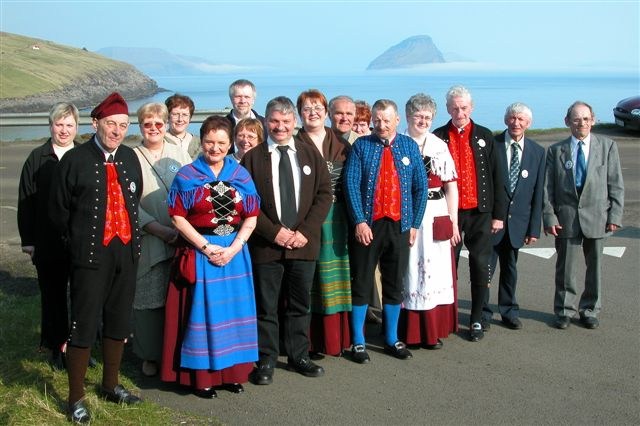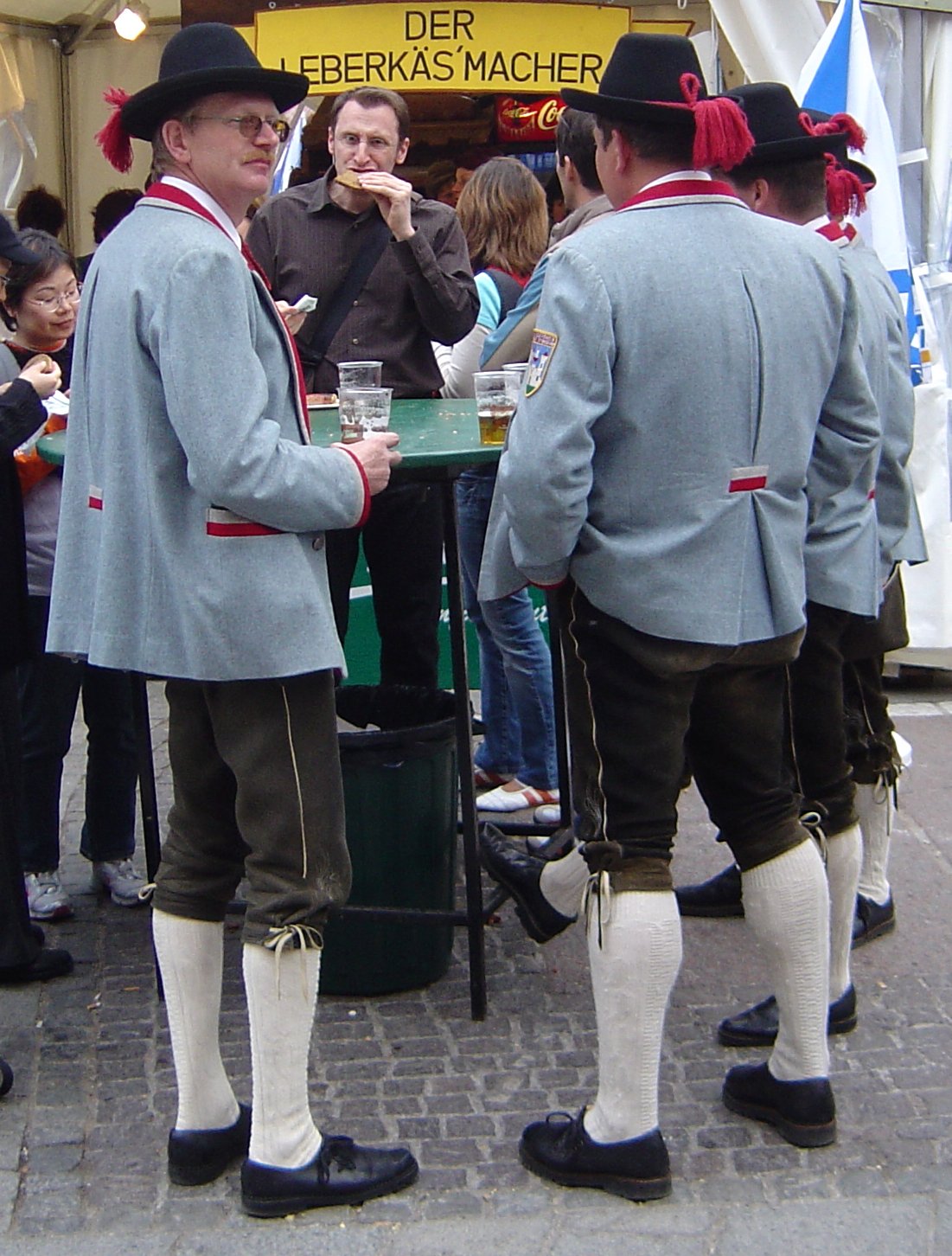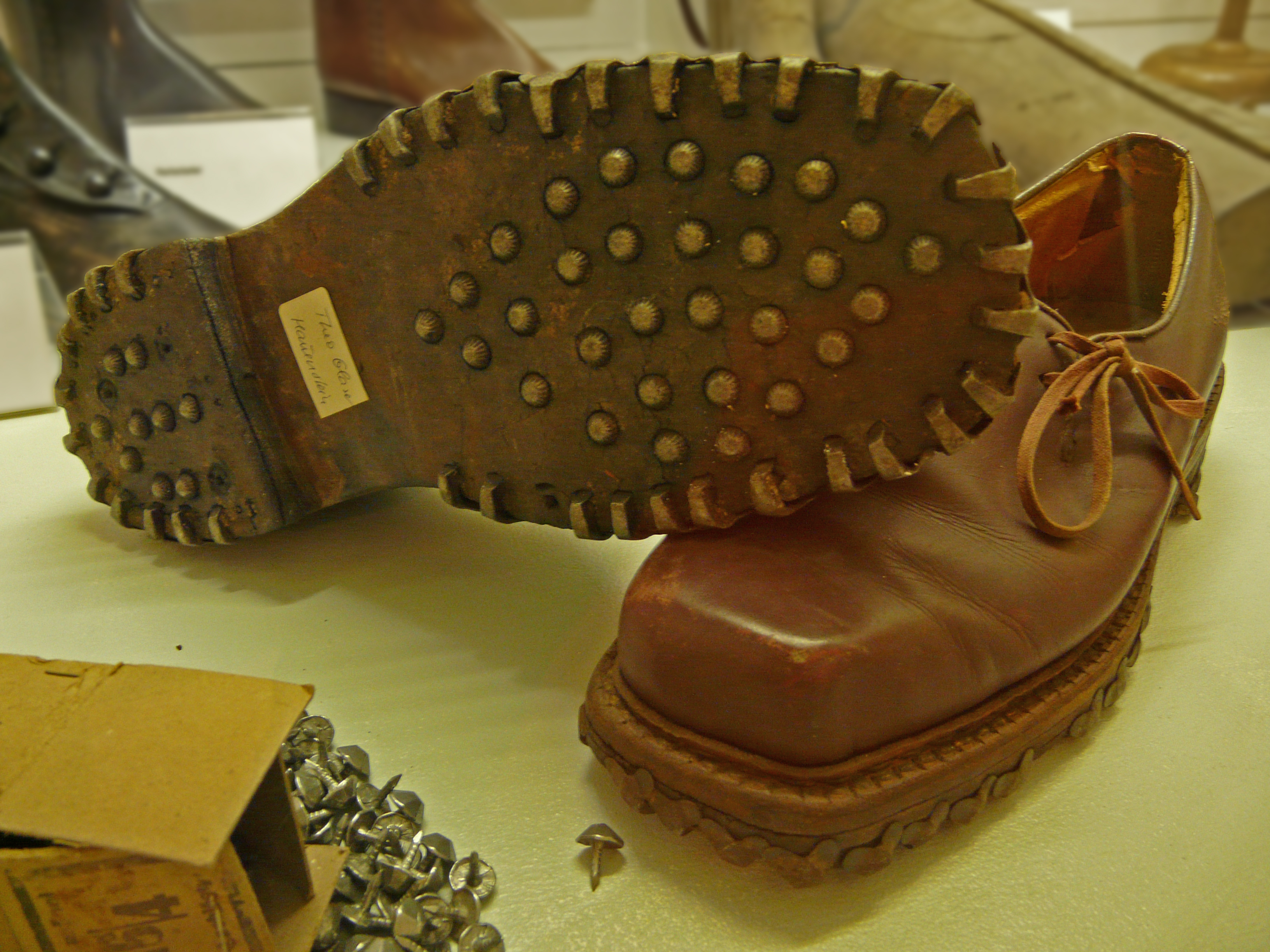|
Lederhosen
Lederhosen (; , ; singular in German usage: ''Lederhose'') are short or knee-length leather breeches that are worn as traditional garments in some regions of German-speaking countries. The longer ones are generally called ''Bundhosen'' or ''Kniebundhosen''. Once common workwear across Central Europe, these clothes—or Tracht—are particularly associated with Bavaria and the Tyrol region. Traditional Bavarian men's clothing Formerly, lederhosen were worn for hard physical work; they were more durable than a fabric garment. Today, they are mostly worn as leisurewear. Lederhosen and dirndl attire is also common at Oktoberfest events around the world. Lederhosen were widespread among men of the Alpine and surrounding regions, including Bavaria, Austria, the Allgäu, Switzerland, the autonomous Italian region of Trentino-Alto Adige/Südtirol (formerly part of Austria-Hungary) and the Alpine area of today's Slovenia. ''La Couturière Parisienne'', however, says that lederhose ... [...More Info...] [...Related Items...] OR: [Wikipedia] [Google] [Baidu] |
Dirndl
A dirndl () is a feminine dress which originated in German-speaking areas of the Alps. It is traditionally worn by women and girls in Bavaria (south-eastern Germany), Austria, Liechtenstein, Switzerland and Alpine regions of Italy. A dirndl consists of a close-fitting bodice featuring a low neckline, a blouse worn under the bodice, a wide high-waisted skirt and an apron. The dirndl is regarded as a folk costume (in German Tracht). It developed as the clothing of Alpine peasants between the 16th and 18th centuries.Gexi Tostmann, ''The dirndl: With instructions''. Panorama, Vienna, 1990. Today it is generally considered the traditional dress for women and girls in German-speaking parts of the Alps, with particular designs associated with different regions. The usual masculine tracht counterpart of the dirndl is lederhosen. In the late 19th century the dirndl was adapted by the upper and middle classes as a fashion mode, and subsequently spread as a mode outside its area of or ... [...More Info...] [...Related Items...] OR: [Wikipedia] [Google] [Baidu] |
Lederhose
Lederhose is a municipality in the Greiz district of Thuringia, Germany. The town has a municipal association with Münchenbernsdorf Münchenbernsdorf is a town in the district of Greiz, in Thuringia, Germany. It is situated approximately 16 km southwest of Gera. The town is seat of a municipal association with eight members. Geography Münchenbernsdorf is located south .... The name is a well-known example of an unusual place name as it is synonymous with the German term for Lederhosen, hence the coat of arms. The name of the village derives probably from the slavic name Ludorad and has no historical link to the piece of clothes. The national A9 expressway has an interchange named after the rather small village which makes the name appearing regularly in traffic reporting via radio. References Greiz (district) {{Greiz-geo-stub ... [...More Info...] [...Related Items...] OR: [Wikipedia] [Google] [Baidu] |
Folk Costume
A folk costume (also regional costume, national costume, traditional garment, or traditional regalia) expresses an identity through costume, which is usually associated with a geographic area or a period of time in history. It can also indicate social, marital or religious status. If the costume is used to represent the culture or identity of a specific ethnic group, it is usually known as ethnic costume (also ethnic dress, ethnic wear, ethnic clothing, traditional ethnic wear or traditional ethnic garment). Such costumes often come in two forms: one for everyday occasions, the other for traditional festivals and formal wear. Following the rise of romantic nationalism Romantic nationalism (also national romanticism, organic nationalism, identity nationalism) is the form of nationalism in which the state claims its political legitimacy as an organic consequence of the unity of those it governs. This includes ..., the pre-industrial peasantry of Europe came to serve as ... [...More Info...] [...Related Items...] OR: [Wikipedia] [Google] [Baidu] |
Tracht
''Tracht'' () refers to traditional garments in German-speaking countries and regions. Although the word is most often associated with Bavarian, Austrian, South Tyrolian and Trentino garments, including lederhosen and dirndls, many other German-speaking peoples have them, as did the former Danube Swabian populations of Central Europe. Name The word "Tracht" comes from the verb "tragen" (to carry or wear); thus the derived noun "Tracht" means "what is worn". So "Tracht" can refer to the clothes which are worn. The noun also has other uses deriving from the verbal meaning, e.g. a load, a device for carrying a load on the shoulders, or the load of honey carried in by the bees). It also appears within the German idiom "eine Tracht Prügel" (a ''load'' (of) beating or, alternately, "a good beating"). "Tracht" is commonly used to refer the way of dressing associated with a particular people group (''Volkstracht''), social class or occupation (''Arbeitstracht''). Most often it refers ... [...More Info...] [...Related Items...] OR: [Wikipedia] [Google] [Baidu] |
Bavaria
Bavaria ( ; ), officially the Free State of Bavaria (german: Freistaat Bayern, link=no ), is a state in the south-east of Germany. With an area of , Bavaria is the largest German state by land area, comprising roughly a fifth of the total land area of Germany. With over 13 million inhabitants, it is second in population only to North Rhine-Westphalia, but due to its large size its population density is below the German average. Bavaria's main cities are Munich (its capital and largest city and also the third largest city in Germany), Nuremberg, and Augsburg. The history of Bavaria includes its earliest settlement by Iron Age Celtic tribes, followed by the conquests of the Roman Empire in the 1st century BC, when the territory was incorporated into the provinces of Raetia and Noricum. It became the Duchy of Bavaria (a stem duchy) in the 6th century AD following the collapse of the Western Roman Empire. It was later incorporated into the Holy Roman Empire, ... [...More Info...] [...Related Items...] OR: [Wikipedia] [Google] [Baidu] |
Oktoberfest
The Oktoberfest (; bar, Wiesn, Oktobafest) is the world's largest Volksfest, featuring a beer festival and a travelling carnival. It is held annually in Munich, Bavaria, Germany. It is a 16- to 18-day folk festival running from mid- or late-September to around the first Sunday in October, with more than six million international and national visitors attending the event. Locally, it is called , after the colloquial name for the fairgrounds, Theresienwiese. The Oktoberfest is an important part of Bavarian culture, having been held since the year 1810. Other cities across the world also hold Oktoberfest celebrations that are modeled after the original Munich event. During the event, large quantities of Oktoberfest Beer are consumed. For example, during the 16-day festival in 2014, were served, making it the year where the most beer was consumed at the Oktoberfest. Visitors also enjoy numerous attractions, such as amusement rides, sidestalls, and games. There is also a wid ... [...More Info...] [...Related Items...] OR: [Wikipedia] [Google] [Baidu] |
Black Forest
The Black Forest (german: Schwarzwald ) is a large forested mountain range in the state of Baden-Württemberg in southwest Germany, bounded by the Rhine Valley to the west and south and close to the borders with France and Switzerland. It is the source of the Danube and Neckar rivers. Its highest peak is the Feldberg with an elevation of above sea level. Roughly oblong in shape, with a length of and breadth of up to , it has an area of about 6,009 km2 (2,320 sq mi). Historically, the area was known for forestry and the mining of ore deposits, but tourism has now become the primary industry, accounting for around 300,000 jobs. There are several ruined military fortifications dating back to the 17th century. History In ancient times, the Black Forest was known as , after the Celtic deity, Abnoba. In Roman times ( Late antiquity), it was given the name ("Marcynian Forest", from the Germanic word ''marka'' = "border"). The Black Forest probably represented the ... [...More Info...] [...Related Items...] OR: [Wikipedia] [Google] [Baidu] |
Biergarten
A beer garden (German: ''Biergarten'') is an outdoor area in which beer and food are served, typically at shared tables shaded by trees. Beer gardens originated in Bavaria, of which Munich is the capital city, in the 19th century, and remain common in Southern Germany. They are usually attached to a brewery, beer hall, pub, or restaurant. History Facilities of this kind existed for example in Bamberg since 1605 under the German term "Bierkeller" ("Beer cellars"). At that time, the Archdiocese of Bamberg was directly subordinated to Rome and not yet to the Duchy of Bavaria. Hence, the first "Biergarten" in the strict sense of the term and of the decree of 1812 by the Kingdom of Bavaria developed at the beginning of 19th century in Munich. While it is unknown which brewery was first, it was likely one of Munich's big six: Löwenbräu, Hofbräuhaus, Augustinerbräu, Paulaner, Hacker-Pschorr and Spaten. Seasonal limitations on when beer could be brewed were already in t ... [...More Info...] [...Related Items...] OR: [Wikipedia] [Google] [Baidu] |
Haferlschuh
The Haferlschuh () is the traditional Bavarian shoe. It was designed originally as a work shoe for alpine terrain, but it can now be worn in a more general setting. In Bavaria it may also be called a ''Bundschuh''. In Austria, it is known as a ''Schützenschuh.'' According to legend, in 1803 Franz Schratt, an alpine shoemaker from Oberstdorf (located in the Allgäu region of the Bavarian Alps), developed the Haferlschuh inspired by the goat hoof. However, Sternke asserts that the Haferlschuh is much older. With a boatlike front and hobnailed sole, the shoes gave the wearer stability. Since 1900, the Haferlschuh has become a part of many alpine Trachten. Nonetheless, the Haferlschuh is still worn as an everyday shoe, and not just for special occasions like Oktoberfest The Oktoberfest (; bar, Wiesn, Oktobafest) is the world's largest Volksfest, featuring a beer festival and a travelling carnival. It is held annually in Munich, Bavaria, Germany. It is a 16- to 18-day folk ... [...More Info...] [...Related Items...] OR: [Wikipedia] [Google] [Baidu] |
Swabia
Swabia ; german: Schwaben , colloquially ''Schwabenland'' or ''Ländle''; archaic English also Suabia or Svebia is a cultural, historic and linguistic region in southwestern Germany. The name is ultimately derived from the medieval Duchy of Swabia, one of the German stem duchies, representing the territory of Alemannia, whose inhabitants interchangeably were called '' Alemanni'' or ''Suebi''. This territory would include all of the Alemannic German area, but the modern concept of Swabia is more restricted, due to the collapse of the duchy of Swabia in the thirteenth century. Swabia as understood in modern ethnography roughly coincides with the Swabian Circle of the Holy Roman Empire as it stood during the Early Modern period, now divided between the states of Bavaria and Baden-Württemberg. Swabians (''Schwaben'', singular ''Schwabe'') are the natives of Swabia and speakers of Swabian German. Their number was estimated at close to 0.8 million by SIL Ethnologue as of ... [...More Info...] [...Related Items...] OR: [Wikipedia] [Google] [Baidu] |






